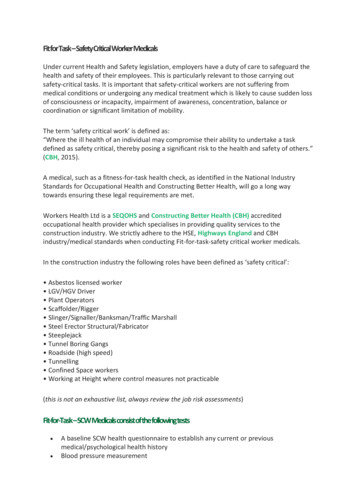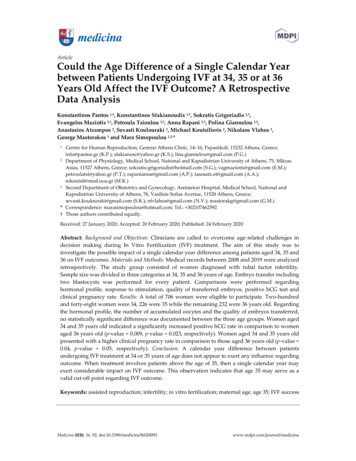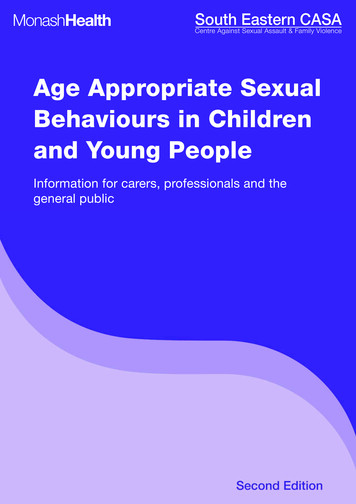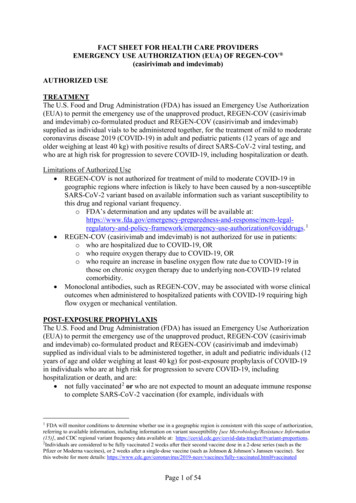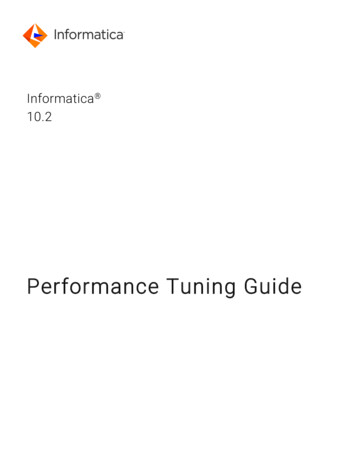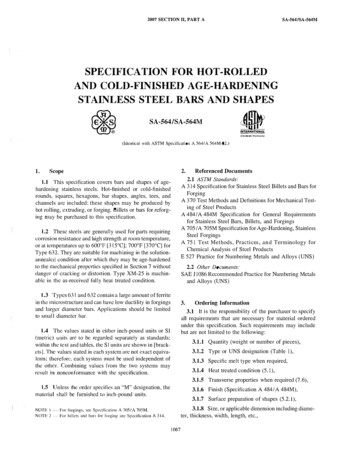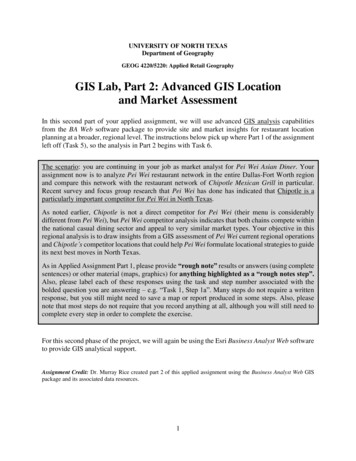
Transcription
FeedbackWe are always pleased to hear howyou use our resources and howyour own school performance ofMacbeth has gone. Please sendany feedback to:BBC School Radio3rd Floor Bridge HouseMediaCityUKM50 2BHOr email us at:schoolradio@bbc.co.ukUsing the MacbethvideosThe videos on the Macbeth webpages use the BBC media player (incommon with all BBC sites). In orderto play the videos you will need tohave Javascript enabled and Flashplayer downloaded.More information: BBC WebwiseIf you are using the resources inschool you may need to create anexemption to your firewall.If you are using Internet Exploreras your browser you will need toensure it is a recent version. Otherbrowsers - such as Firefox, Chromeor Safari - will also work.2Macbethbased on the play by William ShakespeareContentsThe programme titles in these Notes have been hyperlinked: click on the titles to access the content online.PageIntroduction31. Sonic battle62. Destiny73. Temptation84. Assassins95. Witches’ brew106. Dunsinane117. Killing ground128. Finale13Music sheets14
IntroductionWhen shall we three meet again?In thunder, lightning or in rain?Welcome to Macbeth.Each song has its own dedicated page on the site, where you canalso find the episode of the story which accompanies it.There are five videos in the carousel on each page:The story player - use this to watch each episode of the story. Theepisodes relate the main events of Shakespeare’s play and rangefrom about 3 to 6 minutes in length.Whatever your musical experience, this resource can help youand your Key Stage 2 pupils enjoy music in the classroom whileexploring one of Shakespeare’s most famous plays.We’ve created a special adaptation of Macbeth which you canwatch in eight short video episodes and we’ve written eightsongs based on the story episodes - Nigel Pilkington is here tocoach you, one song per programme - and we’ve also provideda playscript to download, which you can use to stage your ownmusical performance of the play.The style of the songs includes raps and chants and rangesfrom blues to anthems to laments.with opportunities for twopart singing along the way.so something for everyone to enjoy!Shakespeare set Macbeth in 11th century Scotland. Macbethis the Thane of Glamis, a successful soldier and loyal to KingDuncan. However, when he meets three strange creatures ona heath and they prophesy that he will become king Macbethbecomes ambitious for power.and his wife, Lady Macbeth, isdetermined he should do whatever is necessary to seize thecrown.Navigating the Macbeth websiteNavigate the content using the navigation bar at the top of eachpage, which links to each of the songs plus a video Clips andResources aggregation page:MacbethAge 9 - 11 Curriculum links:The tutorial player - use this video to learn the song. The tutorialis split into two parts so that you can break from the song to watchan episode of the story.Macbeth is primarily a musicresource for children aged 9 to 11.It has been written to fulfil objectivesof the new music curriculum at KeyStage 2 in England and equivalentcurriculum requirements in other UKnations.Additionally the resource has strongcross-curricular links to English /Literacy and the study of a play byWilliam Shakespeare.Credits:The song player: full vocal and backing track - once you arefamiliar with the song use the full vocal and backing track videos toreally polish your performance. The videos includes all the words ofthe song on-screen.Presenter: Nigel PilkingtonComposer: David ChiltonLyrics: David Chilton / Neil RichardsPlayscript: Neil Richards / MattCostelloLead vocalist: Roy HamiltonAudio producers: Katherine Freeman (song tutorials) and John Taylor(drama episodes)For the BBC: Andrew BarnesBased on the Music Workshop series‘Macbeth’, originally produced byBBC Scotland.3
Macbeth byShakespeareWilliam Shakespeare was born in1564 and spent his life in Stratfordupon-Avon and in London. Macbethdates from 1606, three years afterthe death of Elizabeth I and theaccession of James I.SynopsisScotland in the 11th century. A groupof Scottish rebels has joined forceswith an invading Norwegian armyto threaten King Duncan’s kingdom.Macbeth - Thane of Glamis - andhis friend Banquo lead those loyal toDuncan on the battlefield and theirbravery ensures success.Macbeth and Banquo leave thebattlefield to meet King Duncan, buton their way they come across threestrange creatures - the ‘Weird Sisters’ - who prophesy that Macbethwill become the Thane of Cawdorand one day will be the king. Theyalso prophesy that Banquo’s heirswill be kings.Shortly after, Macbeth learns thathe has indeed become the Thane ofCawdor.and so the prophesyappears to be coming true.Macbeth shares the news of theprophesy with Lady Macbeth.andshe is determined that when KingDuncan arrives at their castle atDunsinane to celebrate the victoryhe shall be killed so that Macbethcan take the crown.4NB Rather than use the video players to rehearse the songsyou can download the videos from the panel named ‘Downloadaudio / video.’ The videos are in mp4 file format and shouldplay using your default media player - for example, WindowsMedia Player or Quicktime Player. Downloading the songvideos will be particularly helpful if you are struggling with aslow internet connection or firewall issues in school.Supporting online resourcesOn each page you will also find links to a variety of downloadsintended to support your use of the videos. These are:PDF downloadsThe pdf files offer: this document - guidance on how to use the resourcesthe Pupils’ pamphlet - the lyrics for each song and someadditonal activities for pupils to completethe Tutorial transcript - a convenient way to read throughthe content of the tutorial audiothe Words for song - the song as an individual pagethe Music for song - the vocal line of each song as music,including chordsthe Playscript - the text of our version of Macbeth, an idealperformance combining all the songs.Audio / video downloadsThese resources are particularly useful if you are having anyissues using the video players. They enable you to downloadsome of the key resources and use them offline. The downloads are: the Tutorial audio - download the mp3 files of Nigel teachingeach of the songs the Song audio (full vocal) - download the mp3 file to singalong to the song the Song audio (backing track) - use this mp3 downloadonce you have become famililar with the song Song video (full vocal) - sing along with the guide vocal andthe lyrics on screen. It is in mp4 file format. Song video (backing track) - the video version of the backing track. Again, it is in mp4 file format.The audio / video downloads also include a .zip file offering allthe music and special sound effects (‘SFX’) needed to put ona performance of the playscript.Listening musicThere is also a short piece of music on each page for appreciation. These have been chosen to illustrate a key musical styleor concept being explored - for example ‘scat singing’. Refer tothese Notes for activities using the listening music.How to use the contentWe have tried to make this resource as flexible as possible sowe hope you will find the way of using it that best works for youand your group. However, here are some suggestions that youmay find useful.The tutorial audioThe song tutorials are the key element for delivering the musiclearning of Macbeth. Each tutorial features a single song andpupils are guided by our vocal coach, Nigel Pilkington. Eachtutorial is about is about 15 minutes long. The pace is livelyso make sure you are ready to mediate the use of the audio.Each tutorial has possible ‘pause points’ indicated in theseProgramme Notes - a natural place to pause so that the groupcan take a break, either to go back over what they’ve learnt orto catch up with an episode of the story.Note: in many tutorials the class will need to split into twogroups at some stage - for example to sing the harmony andmelody parts of a song together. Time is not given in the tutorials for arranging this grouping, so make sure you read theProgramme Notes for each tutorial carefully beforehand andensure each member of the class understands which groupthey are in before commencing the tutorial audio.It is a good idea to print the words of each song from the PDFdownload section and distribute them before commencing. Thelyrics for each song can be found in the Pupil Pamphlet (wherethey appear alongside other information and activities) or asindividual files. Better still - project the words of each song onyour IWB!
The song videosOther things to keep in mind when singing include:Use the song videos once you have learnt the songs using thetutorial audio. The full-vocal version is easy to join in singingalongside our vocalists. Use the backing track once your groupis feeling really confident.Posture: encourage good posture by encouraging children tostand tall, knees loose and feet apart.Both versions of the song video can be downloaded so thatthey can be used offline. The audio-only versions can also bedownloaded.Vocal warm-ups prior to each sessionIt is sensible to ‘warm-up’ before each session. On each pageof the website Nigel invites you to join him for a short (betweentwo and three minutes) vocal warm-up that will help to prepareeveryone for the main song tutorial video.Additional warm-up activities that you can introduce yourselfinclude:Vowels: sing up and down a scale to the numbers 1 - 8, usingB played on a chime bar as a starting note. Ask pupils to omit anumber (eg ‘4’) and sing it silently in their heads and challengethem to pitch the following note (‘5’) correctly. Chage the number to be omitted and increase the ommisions as the childrenprogress.Sing down a scale to ‘Do you chew blue glue?’, ‘We three beesneed trees’, ‘Chocolate and banana sponge’ or other suitablecombinations.After singing down from C’ - C, start the next scale one notehigher and continue higher each time while it remains comfortable.Consonants: ‘Scrape your windscreen with your credit card’.Tongue-twisters: (say or sing as four vowels) ‘Red lorry, yellowlorry; red leather, yellow leather’.Rhythmic chants: use a chant or a rap from Macbeth - suchas the Weird Sisters’ spell.The singing face: encourage pupils to lift their face musclesby smiling. Humming phrases of songs will also encourage anunforced, well-blended sound.Facial: smile - screw up the face - stick out tongue - chewingtoffee - open mouth as widley as possible.Breathing: encourage low breathing (that is without breathinginto the chest and without raising the shoulders) by asking thechildren to imagine an inflatable ring around the waist. Breathein silently through the mouth, causing the ring to inflate all theway round the middle - taking a drink of air that goes right downlow, as if their tummy is a tank of air - hold - and then releasethe air slowly and silently through the mouth. As you breatheout count 1 to 5 slowly, then 1 to 10, controlling a steadyreleasae of air and increasing the time with practise.Technical issuesPlease note that the media player which appears on the webpages requires you to have Flash Player installed on yourcomputer and JavaScript enabled. Further help can be found atBBC WebwiseHow to install Flash Player plug-inWhat is Java and JavaScriptIf you are attempting to view the videos in a school location it ispossible that your school’s firewall will prevent the videos fromplaying. In these circumstances you will need to talk to yourtechnical co-ordinator about adding exemptions to your firewall.If you are experiencing problems you can also contact us at:schoolradio@bbc.co.ukMacbeth - the maincharacters:Macbeth: the Thane of Glamis, asuccessful soldier and initially loyalto King Duncan. Thereafter King ofScotland.The Weird Sisters: three strangecreatures who appear to be able toforetell events.Lady Macbeth: eager to supporther husband’s ambition to becomeking.King Duncan: King of Scotland. Henames his son Malcolm as his heir.Banquo: friend to Macbeth andloyal to King Duncan. The WeirdSisters foretell his descendents willbe kings.Malcolm: King Duncan’s elder sonand rightful successor to his father.Donalbain: King Duncan’s youngerson.Macduff: the Thane of Fife, loyal toKing Duncan. His family are killedby Macbeth.Lennox, Angus, Ross: noblemenloyal to King Duncan who joinMalcolm’s cause.Fleance: son to Banquo.Assassins: Macbeth’s henchmenwho kill Banquo.but fail to kill hisson, Fleance.5
1Sonic battleFocusSinging in unison, moving mainly bystepMusical style1Sonic battleEpisode 1 of the storyScotland in the 11th century. A group of Scottish rebels hasjoined foces with an invading Norwegian army to threaten KingDuncan’s kingdom. Macbeth - the Thane of Glamis - leads theloyal Scottish soldiers on the battlefield, supported by his friendBanquo. Their bravery ensures success.After the battle Macbeth and Banquo go to see King Duncan.On the way they meet three strange creatures - the ‘WeirdSisters’ - who appear to be able to foretell events. They prophesy that Macbeth will become Thane of Cawdor and thereafterKing of Scotland . and they tell Banquo that one day his heirswill also be kings.Steady march with rapDuration of video: 04 18You will acbeth/episode 01.pdfUntuned percussion instruments forthe follow-up activitiesBefore the programmeWarm up the body for singing.Stand up and rotate the shouldersbackwards, forwards, together andindividually.Be ready to split into two groups forthe rap and percussion work.Listening musicAn excerpt from the Symphony No5 by Beethoven, 1st movement.Listen to this famous passagefrom the symphony. Can pupilshear the ‘sequence’ - the pattern ofnotes repeated at different pitches(ie higher and lower)?6The tutorials for ‘Sonic battle’Part 1: http://www.bbc.co.uk/programmes/p04ql4pz (08 26)Part 2: http://www.bbc.co.uk/programmes/p04qlzk6 (06 29)Learning the song ‘Sonic battle’: Learn Verse 1 Learn Verse
There are five videos in the carousel on each page: The story player - use this to watch each episode of the story. The episodes relate the main events of Shakespeare’s play and range from about 3 to 6 minutes in length. The tutorial player - use this video to learn the song. The tutorial is split into two parts so that you can break from the song to watch an episode of the story. The song .

